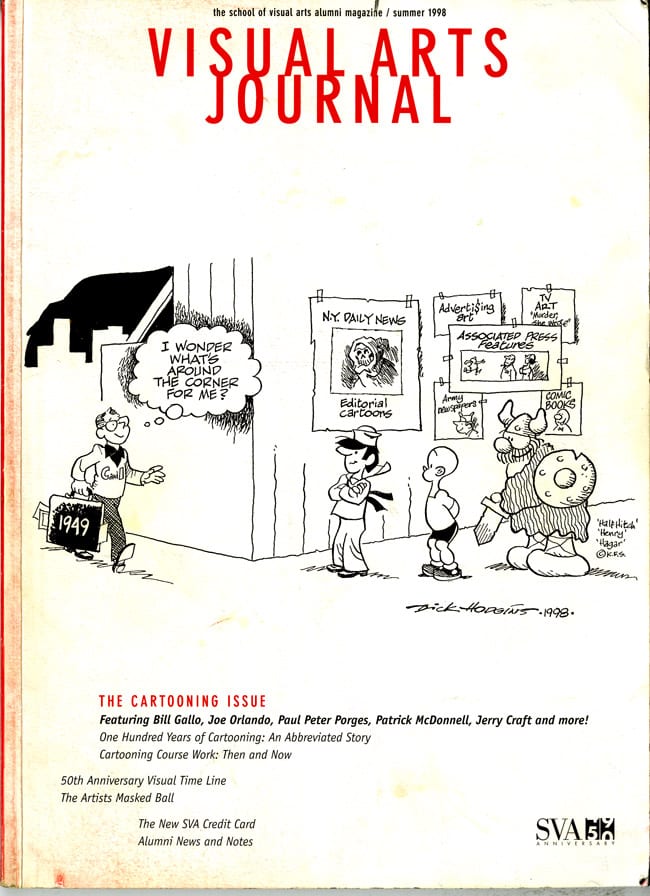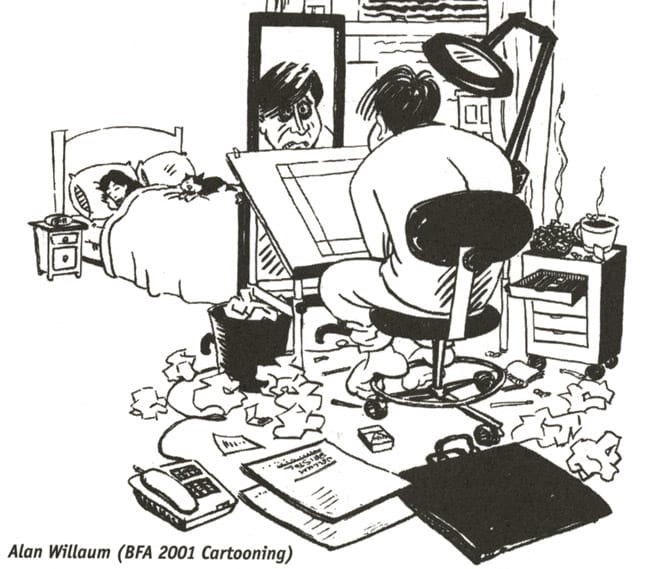The Comics Journal #207 (September 1998)
Yesterday I received the summer 1998 issue of Visual Arts Journal, the alumni magazine for School of Visual Arts. I usually throw these things away, but I had to look at this one, the cartooning issue. I enrolled in SVA in 1987 and heard about the famous graduates and big name teachers, which led me to believe that they cranked out geniuses who all became millionaires by the time they were 22. When I got there, I saw students who couldn’t read and didn’t pay attention in classes they were paying for, professors well past their prime, a placement office that offered nothing more than jobs airbrushing bootleg T-shirts for $5 an hour, and prospective employers who had never even heard of the school. When I was a student and met professionals who had been through the cartooning program, they all told me I was wasting time and should drop out. The summer Journal reaffirms that I should have listened to them.
Silas Rhodes and Jack Endewelt, respectively the SVA founder and illustration/cartooning department chairman, both write brief “hooray-for-us” essays about the legacy of cartooning without mentioning a single example of the school’s impact on the medium or the medium’s effect on society. Rhodes, being a figurehead, probably never sees the work of the students; but Endewelt most likely fails to cite examples because he’s embarrassed by the cartoonists the school turns out. When I attended SVA, cartooning majors complained that Endewelt, an illustrator, was condescending to cartoons. Looking at the quality of their work, I understand why.
“One Hundred Years of Cartooning” by Michael A. McKenzie is a six-page history of the medium, covering what we all have read a million times ... Cave paintings, The Yellow Kid, Little Nemo, Krazy Kat, superheroes, EC, Marvel. The ignorance begins when we get to the ’70s. McKenzie writes:
“... comics developed a social conscience and began tackling subject matter that dealt with large societal problems. Green Lantern took on tenants’ rights and drug abuse... This trend continued right up to the late 1980s and early 90’s when a character in The Incredible Hulk was revealed as HIV positive”
Nowhere is there a mention of underground comics or how they broke taboos long before superheroes did. Even Mad, in its own safe juvenile way, did more to raise public conscience through comics. X-Men is credited with introducing ethnic diversity to comics, and Cerebus by Dave Sims [sic] is said to be the first comic published independently of any of the major companies. Though Maus is mentioned, the writer states Image Comics is responsible for creator ownership, which has validated the viability of independent publishers such as Dark Horse and Event.
When I went to SVA, names like Harvey Kurtzman, Will Eisner, and Art Spiegelman were used to lure young would-be cartoonists. The first two were in their twilight years and not as able-bodied or minded as they once were, but at least they were there. Now you can’t even give SVA credit for salesmanship. On Journal’s course descriptions page, they boast of faculty such as Sal Amendola, Kevin Brownie, and Klaus Janson. Who says giants no longer walk among us?
Now we get to the work of students past and present. “A Day in the Night of a Comic Book Artist” is a portfolio of the best from Joe Orlando’s class. Orlando asked his students to show themselves at their drawing board, and his example can be seen. A young man looks in a mirror above his drafting table trying to get the right face for the page he works on. He is surrounded by tools, and in the background are visions of superheroes, aliens, and spaceships. The results are basically other versions of the same drawing. Most students draw the same lamp and chair but add slight variations like different angles or the ultimate SVA cartooning major’s wish-fulfillment fantasy— a bed nearby with a girl sleeping in it.
Profiles of students and faculty make up the next 20 pages. For every success story like Patrick (Mutts) McDonnell or gag cartoonist Mort Gerberg, there’s coverage of complete nobodies. Did they even bother to contact cartooning alumni like Drew Friedman, Mark Newgarden, Peter Bagge, Kaz, Kyle Baker, Jeff Wong, or Bob Fingerman? No, because if any of them deigned to participate, they would probably admit they succeeded in spite of and not because of SVA.
A profile of graduate Arik Roper mentions his influences as Crumb, Sim, Clowes, Griffin, Woodring, Wrightson, and Bode. The article then apologizes if the names aren’t familiar. Earlier in the magazine, it’s taken for granted that the reader will know what Spawn is (arguably not only the worst comic book ever, but the all-time worst contribution to the history of civilization), but would be stumped upon hearing the name Robert Crumb.
The results of the Alumni Cartooning Survey are printed, with answers to questions as well as samples of work. Most of the respondents either graduated in the ’50s or in the ’90s, with little in-between. The younger superhero artist pieces are completely illegible. I think there’s a guy in the air in one of them and there are some buildings and some kind of… car? The items are well drawn on their own but with all the elements combined, I challenge anyone to make heads or tails out of anything.
A couple years ago my mother sent me an article from the Times because it was about an SVA instructor. The name escapes me but I remember it was about an advertising teacher and it focused on how tough he was because he told people with no talent to give up as he set their assignments on fire. If there were a cartooning teacher like that, the department wouldn’t be such a joke. I think some of the students should have been set on fire as well. I am a cartooning graduate who makes a living in the field, but for some reason was not sent a questionnaire. I will now answer one of their questions anyway.
Did your expectations of/from a career in cartooning change while attending school? How?
Yes. During my senior year I realized that all I had accomplished at that point would have happened regardless of my attending your school. It occurred to me that no editor or art director would give two shits about whether or not I went to SVA. I knew that I would be published, but that my “education” was inconsequential. Like an idiot, I finished anyway. If I owe anything to SVA, it’s that my first few professional jobs were from grads who felt sorry for me for making the same mistake they did.
The rest of the magazine is made up of self-congratulatory backpatting and news about famous people who donated money. The most amusing feature is the alumni news, which reports of various people who are now painting vans and doing spot illos for their local Pennysaver.
Just as older cartoonists advised me not to stay at SVA, I now say the same to younger cartoonists who write to me. I hope that unlike me, they’ll listen. If not, I’ll send them the new Visual Arts Journal.








